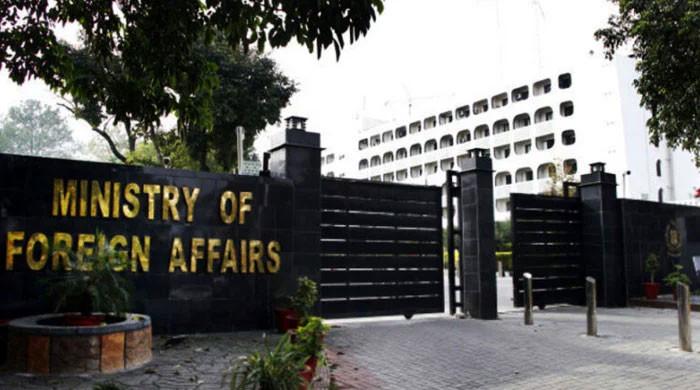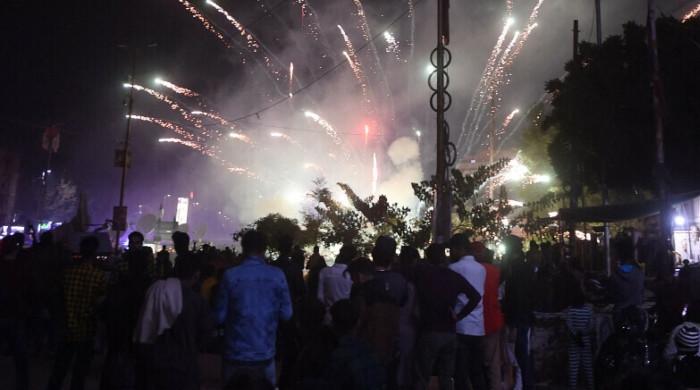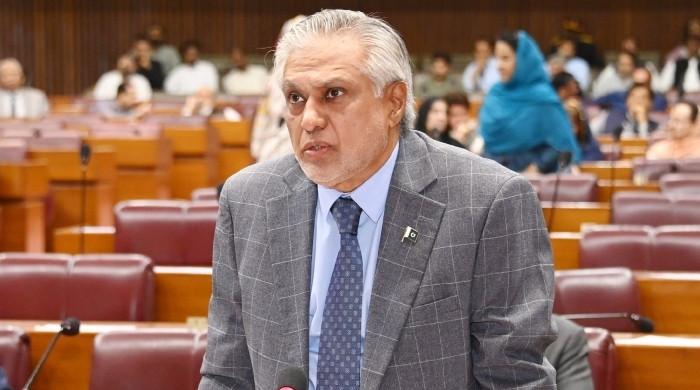K Electric ‘illegally’ overbilled Karachiites in July, netting crores in excess revenue
K Electric prima facie violated NEPRA’s tariff terms by billing customers for 32 days in July instead of legally allowed 30
August 17, 2021
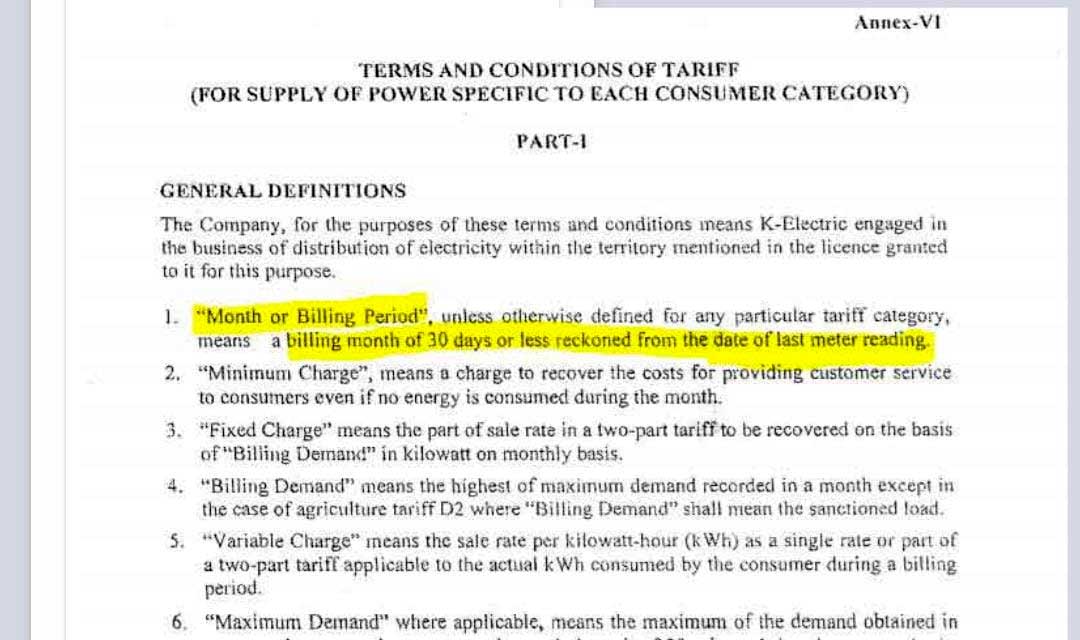
UPDATE: The story has been updated to reflect K Electric's position on the matter.
Residents of Karachi may want to check their household electricity bills to determine whether they were overbilled by K Electric for the month of July.
A Geo.tv investigation has found that the electricity utility seemingly violated the terms and conditions of tariff set by the national regulator by charging customers for 32 days during the month of July, instead of the maximum 30 days allowed under the law.
National Electric Power Regulatory Authority (NEPRA) officials who spoke to this correspondent described the move as ‘illegal’ and that K Electric should provide an explanation.
K Electric in a Tuesday, August 17 statement defended its billing practices, stressing that it follows a standard system and processes in line with prevalent practices in the industry.
It is not fully clear exactly how many individuals were affected, but bills shared with Geo.tv by residents of Gulshan, Korangi, Defence, Scheme 33 and North Nazimabad in Karachi suggest that 32-day billing was done in multiple areas of the city.
K Electric customers can determine if they were issued a 32-day bill by comparing meter reading dates (provided on their bills on page 2, top right of the first column) for the last two months. If the number of days exceeds 30, you may be eligible to lodge a complaint with NEPRA regarding the matter.
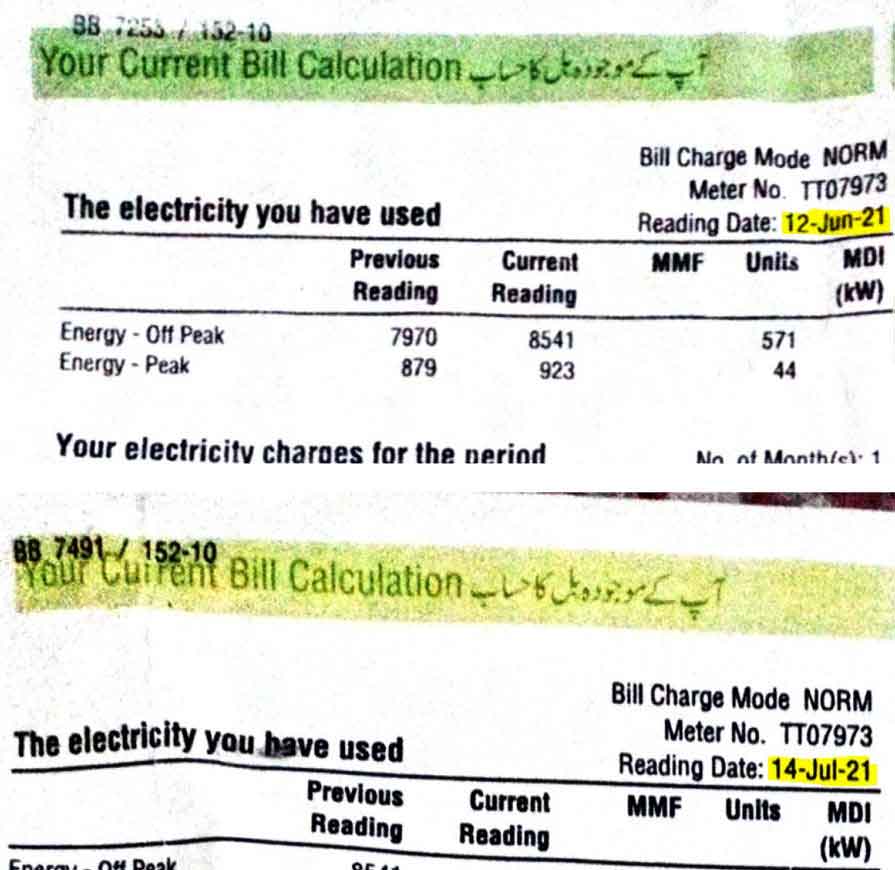
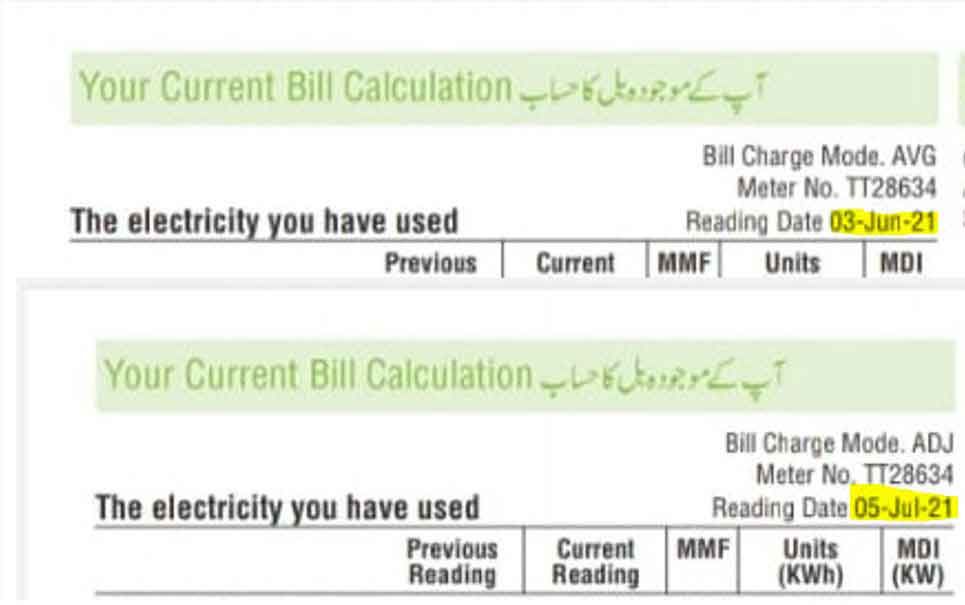
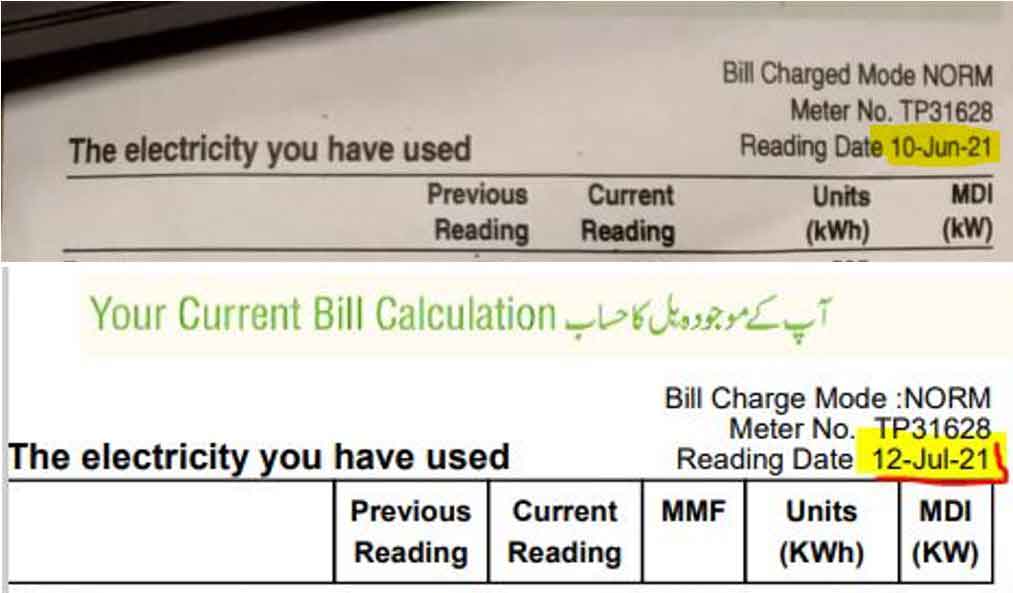
Residential consumers who are billed according to tariff slabs (single phase meter) are likely to have been the most affected, because their bills are particularly sensitive to the number of days they are charged on (more on this later). In particular, single phase meter customers who received bills for between 701-747 units may have been charged around Rs4,000 in excess of what they should have paid.
In its defense, K Electric said in a statement issued on Tuesday, August 17 that: "[...] meter reading dates can correspond to a Sunday or a public holiday. If the meter is located inside the premises, the consumers may not allow staff to enter the premises. In such cases, the date for reading your meter is shifted to the next working day.
"All such instances are immediately recorded; the entire process is automated and digitized with permanent and archival records present in the offices for posterity. If a consumer’s meter reading date falls on the 15th of every month. The 15th of August 2021 was a Sunday, which is a public holiday. The meter reader for your area will visit on the 16th of August – the next working day. In the next billing cycle, the meter reading is taken on the 15th of September, which adjusts the consumer billing to its normal billing cycle."
Geo.tv has provided an easy calculator for K Electric customers who are billed on single phase meter slab tariff. It can be used to calculate how much these customers were overbilled.
Calculator for customers on peak, off-peak billing/three phase meter tariff is provided here.
While the impact of even a few hundred rupees on individual bills may seem like a negligible amount, it is worth mentioning that K Electric has a total 3.2 million customers, majority of whom are residential users.
The multiplier effect would therefore suggest hundreds of millions of rupees netted in additional revenue by K Electric from the citizens of Karachi.
What we discovered
According to copies of bills for the months of June and July shared with us by K Electric consumers residing in different parts of the city, the power company calculated customers’ bills for the month of July using a billing period of 32 days.
This was determined by comparing the Meter Reading Date provided on the bills for the months of June and July. It was further found that the issue did not affect a particular area or a batch of customers: rather, customers whose meter reading dates were as much as a week apart were also billed for 32 days, suggesting that the change may have been a result of a blanket policy.
This is, prima facie, a violation of the Terms and Conditions of Tariff set by the National Electric Power Regulatory Authority (NEPRA) for K Electric under SRO 576 of 2019, which clearly limit the billing period to a maximum duration of 30 days.
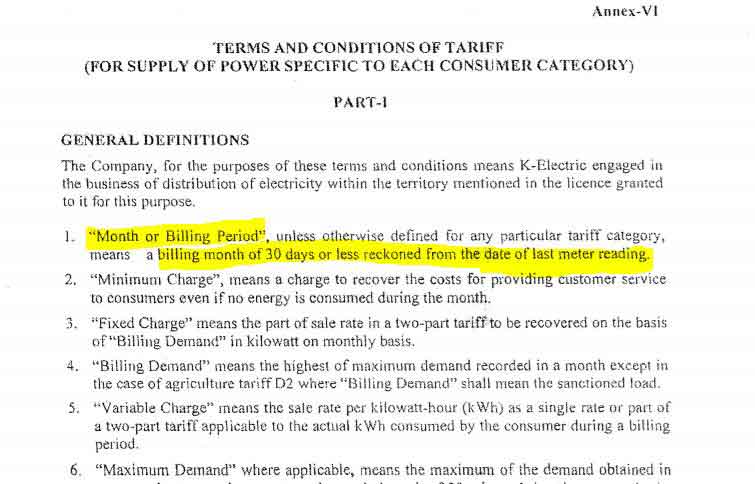
The Terms and Conditions clearly state under Clause 1 of ‘General Definitions’ that “‘Month’ or ‘Billing Period’, unless otherwise defined for any particular tariff category, means a billing month of 30 days or less reckoned from the date of the last meter reading.”
However, in its statement, K Electric said: "[K Electric] understands [National Electric Power Regulatory Authority] NEPRA's stipulation of thirty days is for the calendar months having 30 days and for months having 31 days, the billing cycle would normally reflect a bill of the same duration."
Representatives of the utility, when asked to explain the difference in their interpretation of NEPRA rules and the written terms and conditions of the tariff, said this practice is based on an 'understanding' with NEPRA rather than a formalised arrangement.
It bears mentioning that no such provision or relaxation is explicitly provided for under the written agreement between NEPRA and K Electric itself.
Earlier, when approached for a comment on the matter, NEPRA DG Consumer Affairs Naveed Sheikh unequivocally said the regulator’s rules, including the limitations set on the billing period, are equally binding on all power sector companies, including K Electric.
A senior NEPRA official, who requested anonymity on the matter, underlined that if K Electric is not able to demonstrate that the delays in meter reading were caused by a force majeure event, “the billing would be deemed to have been done illegally”.
How overbilling by KE was determined
The exact number of units of electricity consumed within a billing period is critical, down to the last unit, especially if customers are being billed under tariff slabs (single phase meter).
This is so because under the slab structure, electricity charges rise progressively and sharply the higher the electricity consumption.
The matter was brought to the correspondent’s attention in a bill for the month of July that had 701 units charged over a 32-day billing period.
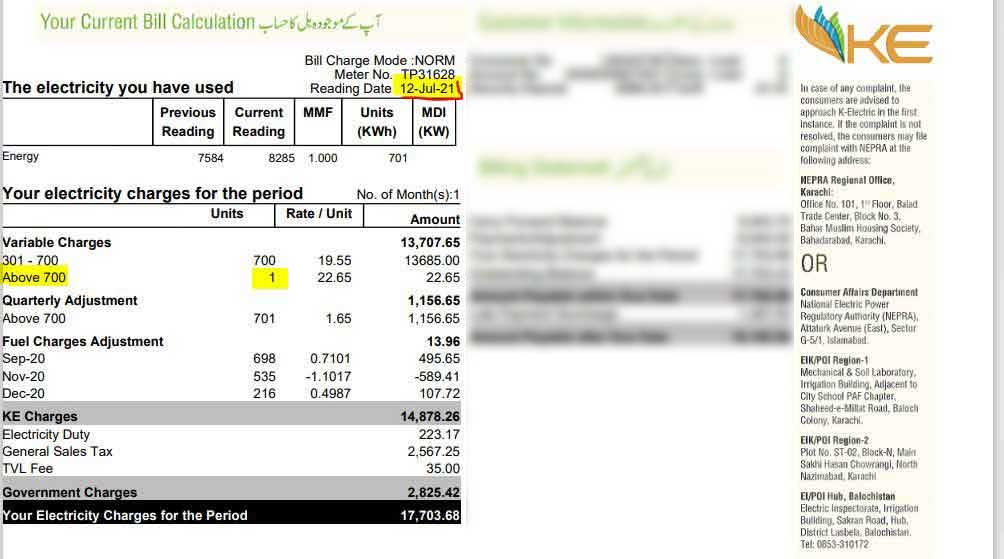
To understand why 701 (or 301, or 201) is a particularly hateful number to see on your bill, we need to look in detail at KE’s tariff, as approved by the National Electric Power Regulatory Authority (NEPRA).
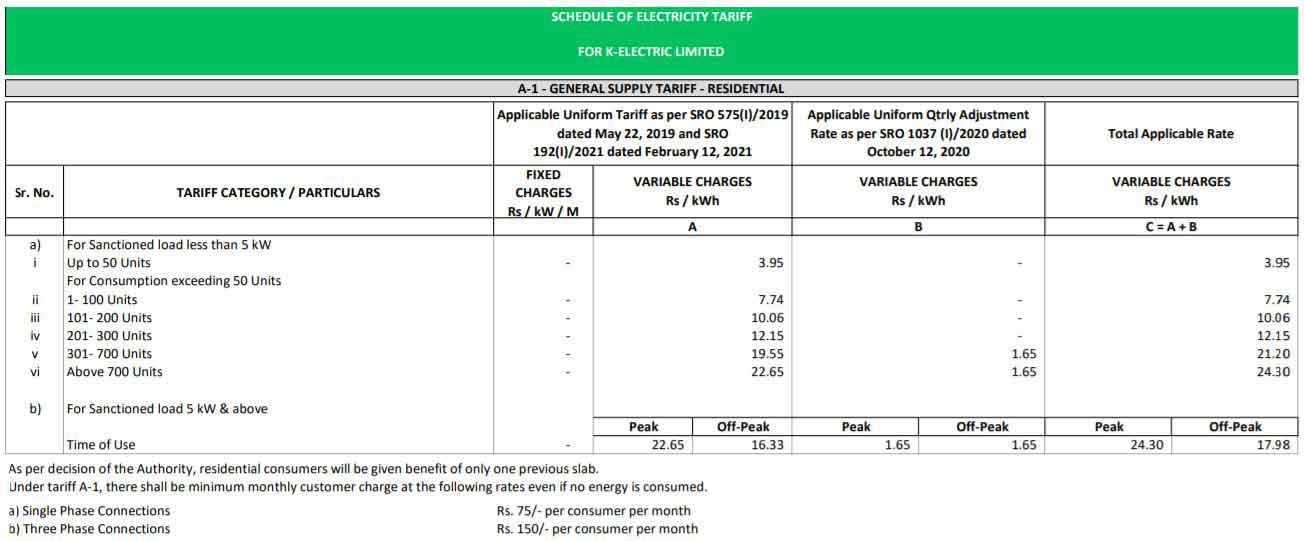
There are two tariff categories for residential consumers: one for consumers who have a sanctioned load of less than 5KW, and the other for consumers who have a sanctioned load of more than 5KW.
Most small houses and apartments tend to fall in the first category (sanctioned load of less than 5KW). This is Category A. This category of consumer is charged electricity on the total number of units of electricity they have consumed over a given billing period, regardless of what time of day the units were consumed.
Meanwhile the other category, Category B, charges consumers for when they consume their units by levying separating charges for off-peak and peak hours.
The overbilling issue affects Category A customers more seriously than Category B customers, as the former’s bills are sensitive to the number of days they are billed for, especially because Category A tariffs progressively penalize consumers the more units of electricity they consume.
Here’s a simplified breakdown of the tariff:
For up to 50 units you are charged Rs3.95 per unit and considered a ‘lifeline’ consumer
However, if you consume more than 50 units, then:
For 1-100 units you are charged Rs7.74/unit
For 101-200 units Rs10.06/unit
For 201-300 units Rs12.15/unit
For 301-700 units Rs 19.55/unit (plus any quarterly adjustment charges)
For 701 units+ Rs22.65/unit (plus any quarterly adjustment charges)
An important rule regarding this slab-based tariff is that customers are charged the two highest slabs based on the total number of units they have consumed.
So, for a 701-unit bill, K Electric can charge the second highest possible rate (Rs19.55/unit) for the first 700 units of electricity used, plus the highest rate (Rs22.65) for the last 1 unit of electricity consumed.
However, if the bill is just 1 unit lower, the billed units will be charged for just Rs12.15/unit for the first 300 units, and at Rs19.55/unit for the next 400 hundred units.
In terms of the cost impact to the customer, the electricity charges for 701 units (without taking into account adjustments, charges and taxes) are: (700 x 19.55) + (1 x 22.65) = Rs13,707.65
And if just 1 less unit of electricity is consumed, (300 x 12.15) + (400 x 19.55) = Rs11,465
So, in a way, that 1 extra unit of electricity ends up costing the consumer more than Rs2,000 due to the tariff mechanism, which automatically increases electricity rates based on the two highest slabs based on total units.
For this reason, the number of days for which the bill has been calculated is equally important. A bill for 701 units for 32 days actually becomes a bill for 657 units if it is averaged to a 30-day period [(701/32)*30]. This means a total of 44 units have been charged extra to the customer in the highest tariff slabs. The difference this makes just in terms of electricity charges is Rs3,803. If taking into account variable charges and taxes, it becomes Rs4,335.
These Rs4,335 are charges that the consumer was never liable to pay if K Electric had followed the legal guidelines for the billing period.
Interestingly, for some customers like the one cited above, the extra charges billed cannot be ‘adjusted’ in the next bill even if K Electric bills them for 28 days to ‘compensate’ for the 32-day billing period a month earlier.
The math is interesting to look at: in the example cited above, the customer uses around 22 units of electricity on average each day. Let's assume that their electricity consumption doesn't change the next month either (even though it's worth mentioning that due to seasonal improvements in Karachi's weather, electricity consumption tends to drop after June and July).
Their electricity charges for this customer over 32 days (22 units per day x 32 days = 701 units) therefore come to Rs14,864, and over 30 days they are Rs11,213. You can use the calculator provided above to plug these numbers in.
The difference between the two bills is Rs3,651. This amount will be pocketed by K Electric.
Now, if the next bill is charged for a 28-day period (22 units per day x 28 days = 616 units), the electricity charges will come to around Rs10,344.
The difference between the 28-day bill (Rs10,344) and the 30-day bill (Rs11,213) for the customer, in terms of electricity charges only, is just Rs869; paltry, compared to the Rs3,651 differential between a 32-day bill and a 30-day bill.
Meanwhile, K Electric has said: "Introducing digitisation and automation in utilities can streamline the process of billing. K-Electric has been investing heavily in installing Automated Meter Readers across its network to digitally record and monitor the consumption of electricity at each tier of the step — grid station, transformer, and individual meters for industrial consumers.
"With time, integrating the Automated Meter Readers within the billing system is going to reduce human intervention and bring greater efficiency into the process. The utility remains committed to supporting and facilitating its customers at all times."
This story was updated at 7:55pm on August 17 to include K Electric's statement and explanations on the matter.




